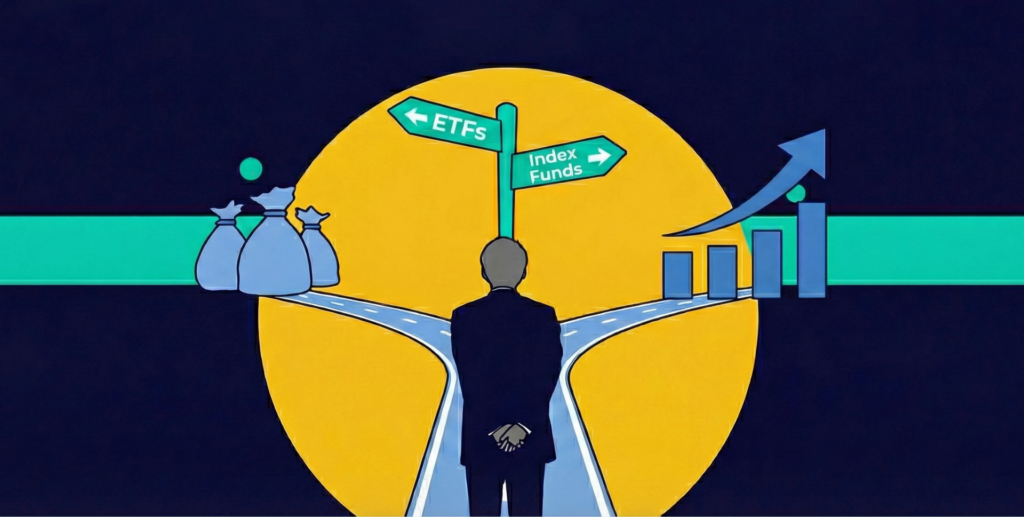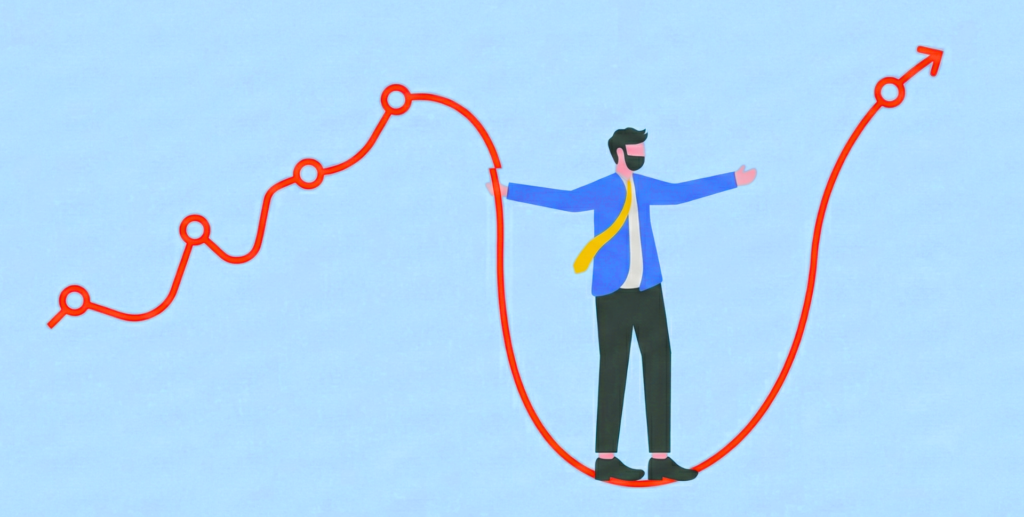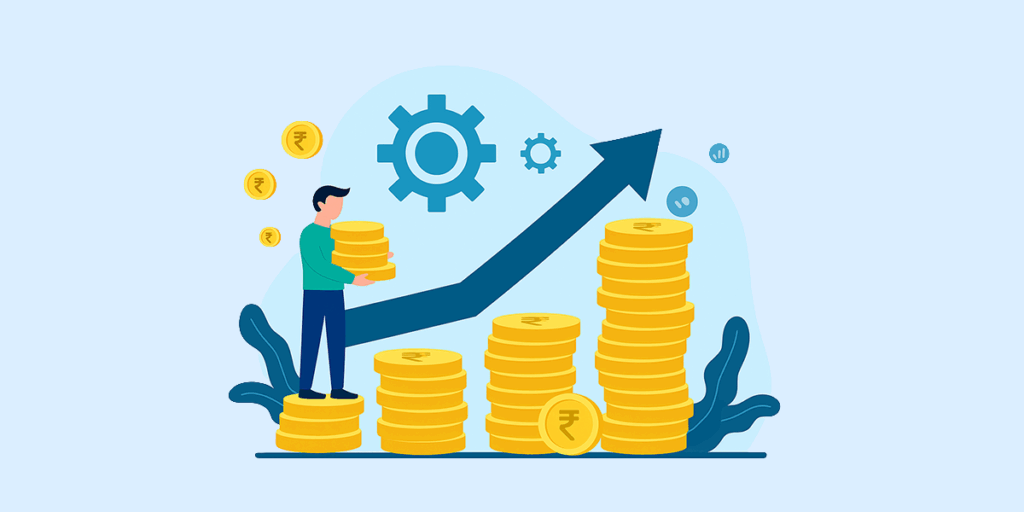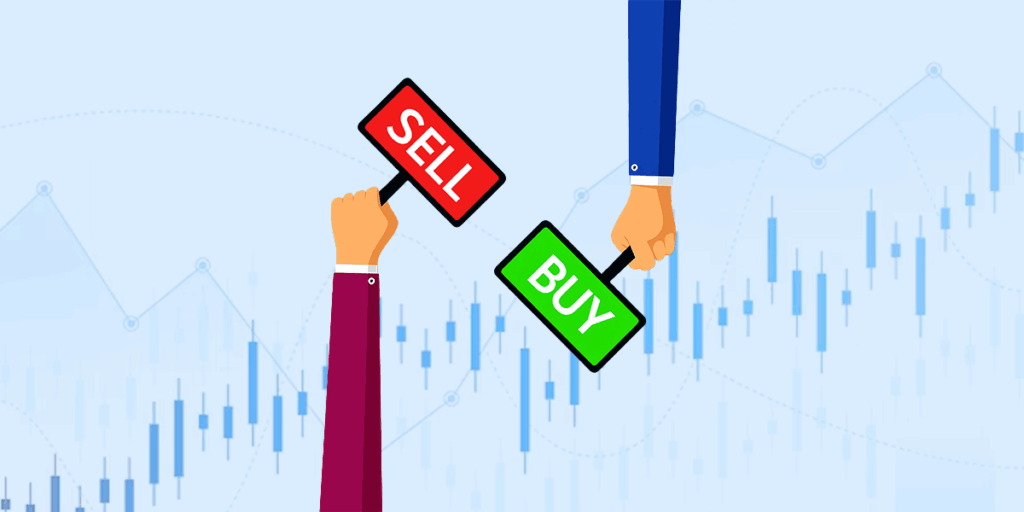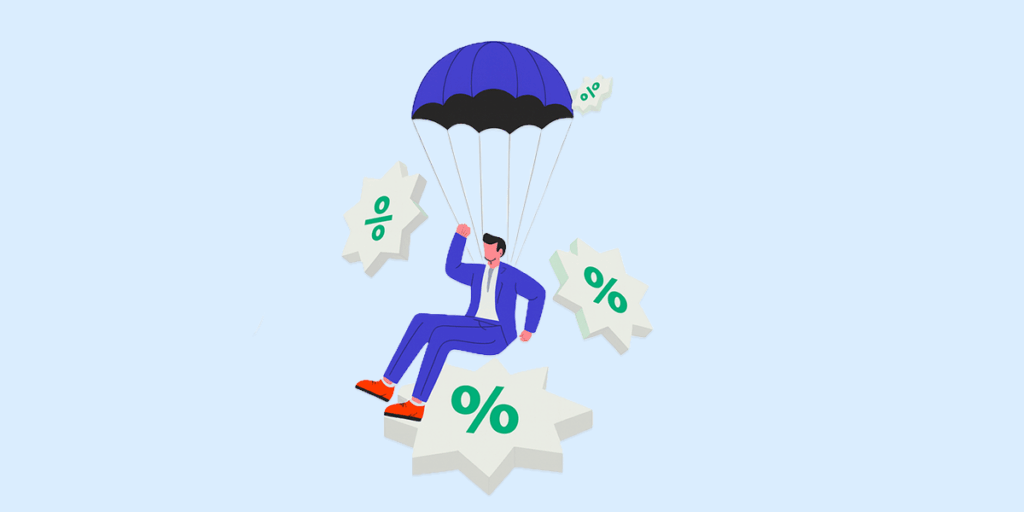Usually, the word “active” has a positive connotation when compared to “passive”: an active lifestyle, active participation, active listening, active learning, etc., as opposed to a passive lifestyle, a passive attitude, etc. But in the world of investing, both active investing and passive investing can help you meet your financial goals and build a solid portfolio. Let’s understand how.
Table of contents
1. What are funds?
2. What are actively managed funds, and how do they work?
3. Why actively managed funds?
4. What are passively managed funds, and how do they work?
5. Why passively managed funds?
6. Differences between actively managed funds and passively managed funds
7. Pros and cons of active vs passive funds
8. Which are better: Active funds or passive funds?
9. Frequently asked questions
1. What are funds?
A fund is a type of investment instrument where money is pooled from multiple investors and managed professionally by a fund manager. This money is used to build a portfolio of assets to meet the specific investment objectives of the fund. Mutual funds and Exchange-Traded Funds (ETFs) are two common kinds of funds.
A key dimension along which funds vary is whether they’re actively managed (active funds) or passively managed (passive funds). The asset allocation and portfolio rebalancing strategies, as well as the level of fund manager involvement in investment decisions, differ in active and passive funds. Owing to this, each of these two types of funds has its pros and cons, and allows investors to meet different financial goals. Let’s take a look at active funds and passive funds in more detail to understand which type will best align with your investment strategy.
2. What are actively managed funds, and how do they work?
Actively managed funds have a fund manager and a team of analysts who follow a hands-on approach to building and managing the portfolio of assets. Depending on the investment objectives of the fund, the fund manager sets specific criteria and strategies for asset allocation and rebalancing.
Actively managed funds aim to beat the market and offer returns to investors that are higher than the market average. Thus, they keep constant track of changing market conditions to make the most of short-term fluctuations and market inefficiencies. Decisions to buy, sell, and rebalance the portfolio are actively made based on quantitative and qualitative analysis of several market and economic trends and factors to maximise returns.
Hence, the expertise of the fund manager and their team plays a crucial role in actively managed funds. The decisions made by the fund manager and the investment strategy adopted by them are central to the performance of actively managed funds.
3. Why actively managed funds?
One of the primary reasons to opt for actively managed funds is their potential for outperformance. The fund management team conducts in-depth research and analysis to figure out how to beat the market or the fund’s benchmark index to deliver higher returns to investors.
Actively managed funds have the flexibility and capability to react to changing market conditions and reduce risk. During times of volatility, the fund manager can decide to reduce exposure to specific assets. They can also make strategic and timely decisions to move away from underperforming assets and ensure that the capital of the investors is optimally utilised at all times.
4. What are passively managed funds, and how do they work?
Passively managed funds track a specific market index and aim to replicate its performance. Unlike actively managed funds, they do not try to outperform the market or the benchmark index, but simply to mimic the latter’s returns.
While passively managed funds also have a fund manager who looks after the fund’s portfolio, their role here is minimal. They do not undertake active stock picking or asset allocation, as the portfolio is constructed to replicate the chosen index. For instance, an S&P 500 index fund would include all the stocks that the S&P 500 market index holds (with the quantities of the stocks potentially being decided using a criterion such as market cap). Hence, the primary responsibility of the manager of a passively managed fund is to ensure that it closely tracks and replicates the performance of the benchmark index.
Instead of constantly tracking changing market conditions and economic trends and accordingly making buy/sell decisions, the portfolio is simply rebalanced periodically to ensure that it remains aligned with the benchmark index’s components.
5. Why passively managed funds?
One of the key benefits of passively managed funds is that they come with lower expense ratios (i.e. the fund’s management fees as a proportion of the amount invested) as compared to actively managed funds. Since passive funds only aim to replicate the performance of a benchmark index instead of outperforming it, the level of management required is minimal. Also, expenses related to research, analysis, and trading are lower.
Another reason to consider passively managed funds is the absence of human bias in investment decisions, which can help deliver consistent returns over the long term. In other words, passively managed funds are immune to any poor decisions the fund management team might take in an attempt to outperform the market.
6. Differences between actively managed funds and passively managed funds
Here are some key differences between active vs passive funds:
6.1 Management style
One of the primary differences between passive and active investments is the management style. In active funds, the underlying securities are bought and sold actively based on the fund management team’s analysis and the market outlook to align the portfolio with the fund’s specific investment objectives, which could be long-term wealth generation, capital preservation, etc. Conversely, passive funds follow a predetermined set of rules to mirror a benchmark index’s composition and weights.
6.2 Costs
Active funds tend to have higher expense ratios, given the high level of management and research required. This can eat into the returns of your investment over the long term. Passive funds, however, are cost-efficient and tend to have lower expense ratios.
For instance, the average expense ratio of actively managed equity funds in the US is around 0.68%, while that of passively managed funds is 0.06%. This massive difference in expense ratios of active funds and passive funds can be seen in India as well.
6.3 Performance objective
Another key difference between active vs passive funds is their performance objective. Active funds aim to provide returns to investors that outperform the market, while passive funds simply aim to replicate the returns of a benchmark index. Hence, the expertise of the fund manager is crucial in actively managed funds as they need to pick the investments that are capable of outperforming.
6.4 Transparency
Active funds do not provide a high level of transparency to the investors with regard to the holdings and investment decisions. While such information is periodically disclosed, it’s not accessible in real-time.
On the other hand, passive funds are more transparent about the strategy followed, and information about portfolio holdings and decisions is typically more accessible to investors.
6.5 Returns
While actively managed funds do aim to outperform the benchmark index, they may not always do so, as that depends significantly on the expertise of the fund manager. Hence, the returns of actively managed funds can differ widely — some may manage to deliver, while others may end up underperforming.
The returns of passively managed funds are more stable and consistent as they aim to replicate that of the benchmark index. Even though they may not exactly match the returns of the benchmark, they don’t tend to significantly underperform either.
6.6 Risks
Active funds tend to have a higher level of risk because the flip side of outperformance is underperformance, and which way the fund goes depends on the decisions taken by the fund manager. As for passive funds, the primary risk they face is what’s known as the tracking error, which is the deviation of the fund’s performance from the benchmark index.
6.7 Tax efficiency
Passive funds tend to be more tax-efficient as they have a lower turnover and tend to have fewer capital gains distributions. Conversely, active funds undertake frequent buying and selling, which results in more capital gains distributions, which can result in higher tax liabilities for investors.
6.8 Flexibility
The fund managers of active funds have a greater level of flexibility and can adapt to changing market conditions based on their research and discretion. This is not true for passive funds, as they tend to have a set of predetermined rules and afford less flexibility to the fund manager in decision-making.
7. Pros and cons of active vs passive funds
Let’s look at the pros and cons of both these types of funds to better understand their differences and role in your portfolio.
7.1 Pros of actively managed funds
7.1.1 Professional management
For most retail investors, active investing by themselves is not possible either due to time constraints or a lack of market knowledge. Active funds help solve that issue by letting you invest your money in funds that are managed by professionals with years of experience and a range of resources for in-depth research and strategic decision-making.
7.1.2 Performance potential
Due to active management by skilled fund managers, active funds have the potential to outperform the market. Fund managers make strategic decisions to deliver higher returns and try to make the most of market inefficiencies.
7.2 Cons of actively managed funds
7.2.1 Higher costs
One of the biggest downsides of actively managed funds is their higher expense ratio. Active funds can have expense ratios as high as 2.5%, and this can erode your returns over time.
7.2.2 Manager risk
Whether or not the actively managed fund outperforms the benchmark greatly depends on the skills of the fund manager and the decisions they make. If the fund manager makes poor decisions or there is a change in the fund manager, this can negatively impact the returns of the fund.
7.2.3 Tax inefficiency
Since actively managed funds undertake frequent buying and selling of securities, they tend to have a higher portfolio turnover. This can result in higher capital gains distribution which can attract taxation even though the investor has not sold the units of their fund. Hence, actively managed funds may be tax-inefficient.
7.3 Pros of passively managed funds
7.3.1 Lower costs
Since the fund manager’s role is limited to ensuring that the fund replicates the performance of the benchmark index, the expense ratio of passively managed funds tends to be lower than that of actively managed funds. This can result in significant cost savings over the long term.
7.3.2 Tax efficiency
Passively managed funds only buy and sell securities to ensure the fund’s composition and weights remain aligned with the benchmark index. Hence, the portfolio turnover is lower than that of actively managed funds, resulting in fewer instances of capital gains distribution. This reduces the tax liability of the investor, making passively managed more tax efficient.
7.4 Cons of passively managed funds
7.4.1 Low flexibility
Passively managed funds are bound by the benchmark index’s composition and weights, and hence, they have low flexibility to make active investment decisions even when market conditions are changing.
7.4.2 Forced buying and selling
In order to not deviate from the benchmark index and maintain a low tracking error, passively managed funds may be forced to buy securities that are overvalued and sell securities that are undervalued. This can result in trading decisions that may not maximise returns even if there is the potential to do so.
7.4.3 Weighting methodology
Passively managed funds tend to follow the weighting methodology of the benchmark index, which may not always be aligned with an investor’s risk tolerance and preferences. For instance, most market indices follow market-cap weighting methodology, which results in a few large companies having a significant impact on the index’s performance. This is not great for risk management.
8. Which are better: Active funds or passive funds?
Both active funds and passive funds can be advantageous for your portfolio. To determine which is better, you have to consider your financial goals, risk tolerance, investment horizon, and preferences. For instance, if you want a cost- and tax-efficient way to invest and your investment horizon is long, you can consider passive funds. But if you are okay with bearing higher investment costs for possible outperformance and also have a moderately high risk appetite, you can opt for active funds.
The best part about building your investment portfolio is that you can invest in several types of investment instruments and don’t have to limit yourself to just one. Hence, you can invest in a combination of active funds and passive funds. To figure out what kind of funds you should invest in and in what proportion, you can make use of Artificial Intelligence (AI).
Through Appreciate, you can get access to a special AI-curated investment portfolio that is tailored to your risk tolerance and financial goals. This will not only help make managing your investments easier through investment app but also allow you to maximise your returns while minimising risks. Download the app today!
9. Frequently asked questions
9.1 Is it better to invest in active funds or passive funds?
Both active funds and passive funds come with their own distinct pros and cons, and neither is better as an investment than the other. Ultimately, the decision to invest in active or passive funds depends on what your financial goals, risk tolerance, and investment horizon are.
9.2 Why are passive funds better than active funds?
In some aspects, passive funds offer an edge over active funds. For instance, passive funds tend to have a lower expense ratio than active funds. They are also more tax-efficient than active funds.
9.3 How often do actively managed funds outperform passive funds?
The outperformance of actively managed funds in comparison to passive funds depends on various factors, such as the chosen benchmark index, duration, asset class, market conditions, etc. In the US, over a 10-year period, only 25% of active funds beat their passive counterparts. However, in India, a higher proportion of active funds tend to outperform. In 2021, 60% of active funds beat their benchmarks.
9.4 Why might someone choose to invest in a passively managed fund?
Investors who want to invest in a low-cost manner for the long term may choose to invest in a passively managed fund. Moreover, a lot of passive funds offer broad diversification across asset classes and sectors. They are also transparent in their holdings and investment strategy and tend to be more tax-efficient than active funds.
9.5 What risk do passive funds eliminate?
Passive funds don’t rely on the skills and decisions of the fund manager, and hence, they eliminate manager risk and bias. Since passive funds replicate the composition of the benchmark index, they also eliminate security selection risk and high turnover risk.
9.6 Why choose actively managed funds?
Actively managed funds have the potential to outperform the market and generate higher returns if the fund manager is experienced and skilled enough, and takes good advantage of market inefficiencies and short-term fluctuations well. Hence, they can be a good choice for your portfolio if your risk tolerance is moderate to high.
9.7 Is passive investing high-risk?
No, passive investing is typically not high-risk. There is often broad diversification, lack of human bias, and low costs. However, despite being lower-risk as compared to active investing, passive investments, like all investments, carry a certain level of risk.





